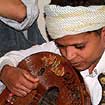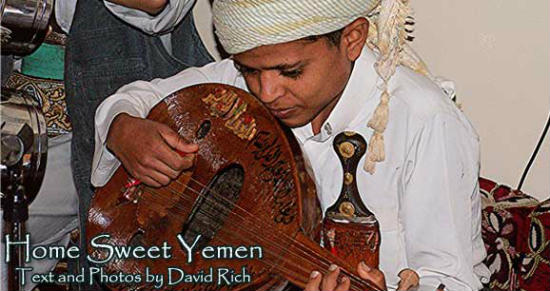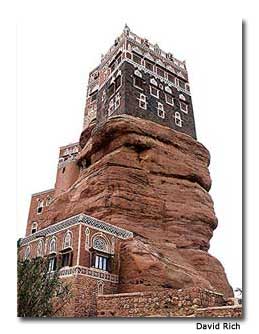

There are travel guides out there who describe Yemen as safer than where you come from. Perhaps it is because this country at the southern tip of the Arabian Peninsula has had none of its formerly famous kidnappings since 9/11. When terrorism swept the world in 2001, it apparently left Yemen. Now European and Japanese tourists are flocking to ancient Arabia Felix (Lucky Arabia), Yemen’s name in antiquity when Solomon and the Queen of Sheba ruled the world and Yemen’s incredible desert palaces and hilltop towns began sprouting up.
Yemen (population 20 million) is eye candy where tourists snap photos with abandon. Start your visit in the capital of Sana’a — its Old City with gingerbread-like condos liberally sprinkled with fancy white frosting in intricate patterns. On the edge of Sana’a, 9 miles (15 km) outside of town in Wadi Dhar sits an ancient castle stacked high on a red rock skyscraper. Dar al-Hajar is the most popular symbol of Yemen seen on posters and in magazines.
Don’t miss Thula and the old Turkish fortresses built high on the mountains 37 miles (60 km) northwest of Sana’a. Thula is a charming pre-Islamic town with tower houses and aqueducts and cisterns.
Make sure to visit tiny mesa-topped Kawkaban, a miniature town propped high above the 16th century city of Shibam. Kawkaban, with its primordial cave homes, sits on a sheer cliff 1,100 feet (350 m) straight above Shibam and was built to protect it.
The World Heritage Site of Shibam is located 30 miles (48 km) west of Sana’a. Shibam is nicknamed the “Manhattan of the Desert” because of its impressive tower-like structures that rise straight out of the cliffs. Surrounded by a fortified wall, Shibam is regarded as one of the oldest and best examples of vertical urban planning.
Al Hajjarah, 74 miles (120 km) northwest of Sana’a and high on a mountaintop, is a charming postcard town, fortified with lots of dry stone construction. From there, the ancient town of Old Ibb (124 miles or 200 km south of Sana’a) spreads over a precipitously craggy mountain. See the stunning mosques of Jiblah (3 miles or 5 km southwest of Ibb) and marvel at the view from high on the mountain over Ta’izz (39 miles or 64 km south of Ibb). The white powder beaches of the Red Sea are another big draw. Yemen is tourist excitement central.
Another interesting thing about Yemen is the fact that at first it doesn’t look so safe. My initial impression was that everyone wore a wicked-looking dagger, either pea green or yellow. These scary items are usually stuck in a golden belt worn over white djellabahs (long, loose hooded garments with full sleeves) and underneath turban tablecloths seemingly pinched from Italian restaurants. After the initial shock of a populace armed to the teeth wore off, I realized the daggers were all ceremonial. During my weeks in Yemen I only saw daggers unsheathed twice: the first time at the traditional Yemen dance exhibition where the men sashay arm-in-arm while brandishing their daggers like candles. The second time I saw them unsheathed was when the driver of an 18-wheeler cut another one off and they zoomed down the highway waving daggers at each other while fiercely scowling over bristly mustaches; far more comical than the .347 Magnums wielded in road rage where I come from.
Eastern Yemen takes a little more getting used to. There you learn the lessons of the desert. The first is to always give a man a ride who is hitchhiking with a Kalashnikov. The residents of eastern Yemen all tote Kalashnikovs, trusty Russian machine guns that make a de rigueur fashion statement on the road to Mareb. The wild, wild east looks like a lawless part of Yemen at first. But not a single shot was fired during my journey to the east. Many of those carrying Kalashnikovs looked suspiciously like mustachioed Woody Allens in slightly soiled lavender dresses, hardly formidable. However, I also learned the second rule of the desert. Always ask first before taking a photo of a guy with a Kalashnikov. Whew. Heart be still.
Security is tight in Yemen, with military roadblocks outside many towns. At one point near Mareb, there were three in three miles (5 km). My strategy for safety was telling everyone that I was not American, but Canadian. Sweet, safe Canada which has never invaded another country in its entire history. We’d roll up to a roadblock with my driver — hiring a car and driver is the best way to get around — shouting, “Kennedy, Kennedy,” as he handed over a copy of my tourist travel authorization. I’d do a double-take, thinking my cover was being compromised by reference to the late U.S. president. Arabic-accented English takes getting used to, even if they’re only saying something as innocuous as Canada.
More dangerous than the ever-present military with their Kalashnikovs and a populace with daggers, is Yemeni multitasking. I’d cower in the back seat of the Land Cruiser I hired, while my driver passed on blind curves above sheer cliffs, dipped into his plastic bag to chew narcotic Qat(pronounced ‘kot’), puffed on a cigarette and chatted on a cell phone simultaneously as we were serenaded by an Arabic music tape on full blast. I learned to prefer Kalashnikovs and daggers.
My driver carefully explained that multitasking is no big deal. “Qat makes me strong,” he said.
Qat (also known as khat) is the drug of choice for all Yemeni males, from cops directing traffic to the military at checkpoints to every man on the street. The stimulant-containing leaves of the shrubby evergreen Qat bush, or Catha edulis, look like shrunken basil leaves and are sold literally everywhere, in bundles or still fresh on the branch, in every town on every block. Starting about noon, everyone is in the market for buying, inspecting, sampling and literally stuffing their faces with Qat leaves for hours until the wad in the cheek is the size of a softball or grapefruit, pouched out like four-inch mumps.

So I had to try Qat. After the first time, I said never again. But I finally tried it twice, mainly because it’s the principal hobby of Yemen’s entire population. Qat is nasty stuff, like chewing hay. It takes hours of pinching the stimulating leaves off of stems, stuffing them in the mouth, chomping them to soup while desperately trying to form a wad of green goopy fluorescent mash that sticks to the inside of cheeks, lips and gums, while oozing out the mouth in an unseemly grasshopper-like drool. Qat didn’t do a thing for me unless you count exasperation.
Then I ran into a fellow ex-pat who was in the middle of a considerable Qat cud and asked him about it. He said, “You have to chew it six or seven times to get anything out of it.”
I just looked at him because that adds up to 18 or 20 hours of chomping hay. I said, “That’s an awful lot of work,” but he was too busy chomping, happily flashing a sloppy green grin.
I never saw women chewing Qat, but then, except for European tourists, I never saw women during my weeks in Yemen. I did see hidden souls covered from tip to toe in flowing black dresses floating down the streets. I’m told they go Qat-less, but exude their own sweet spice.
Home sweet Yemen. Safer than staying home. After chewing an entire Qat bush about the sixth or seventh try, you may never want to leave.
If You Go
For a tour guide agency in Sana’a, hook up with Abdul al Fatah Alrefue, + 967-1-287270, MOB 00967-73756155, email [email protected] or [email protected] and for a super deal say I sent you. Abdul’s prices are approximately 70 percent less than that of other tour companies (of which there are dozens) and his service is superb. However, all Yemeni drivers can be iffy. Abdul will find you a topnotch hotel with a normal rack rate of US$ 50 for US$ 16 and will customize any tour from one to 24 days. The Arabia Felix is a quaint old hotel worth checking out at the edge of Old Town Sana’a and costs US$ 22 per night, double. All hotels include a breakfast buffet. Yemeni food is uniformly tasty and inexpensive, from miniature baguettes to roast chicken with salsa.
Yemen Tourism Promotion Board
